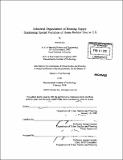| dc.contributor.advisor | Joseph Ferreira. | en_US |
| dc.contributor.author | Seo, Wonho | en_US |
| dc.contributor.other | Massachusetts Institute of Technology. Dept. of Urban Studies and Planning. | en_US |
| dc.date.accessioned | 2010-08-31T16:19:03Z | |
| dc.date.available | 2010-08-31T16:19:03Z | |
| dc.date.copyright | 2010 | en_US |
| dc.date.issued | 2010 | en_US |
| dc.identifier.uri | http://hdl.handle.net/1721.1/57877 | |
| dc.description | Thesis (M.C.P.)--Massachusetts Institute of Technology, Dept. of Urban Studies and Planning, 2010. | en_US |
| dc.description | Cataloged from PDF version of thesis. | en_US |
| dc.description | Includes bibliographical references (p. 79-81). | en_US |
| dc.description.abstract | The housing supply is affected by the market, regulation, land use, and capital. Research has revealed a strong variation between the supply sector and builders' behavior patterns. Understanding these variations will contribute not only to better performance of private homebuilders, but also to more efficient housing supply policy. Somerville's impressive research, 'The industrial organization of housing supply (1999)' integrates systematic factors into home builders' organizational structure. In adapting his research model, I explain builders' size distribution in markets defined by Metro Statistical Area (MSA). I divided market factors into size, demand and cost factors, and housing values. The impact of the regulatory environment is refined by separately testing the formal restriction, community discretion and control, and jurisdiction structures' effects. Land issues are measured by amount of developable area and needs of assembly for proper size of development. The results show that the firm size responds to price changes most sensitively. The effect of market size shows that large area gives more growth opportunities to firms. The amount of developable land shows higher impact on firm size than increased demand does. Density restriction and approval delay tends to increase builder size. | en_US |
| dc.description.statementofresponsibility | by Wonho Seo. | en_US |
| dc.format.extent | 95 p. | en_US |
| dc.language.iso | eng | en_US |
| dc.publisher | Massachusetts Institute of Technology | en_US |
| dc.rights | M.I.T. theses are protected by
copyright. They may be viewed from this source for any purpose, but
reproduction or distribution in any format is prohibited without written
permission. See provided URL for inquiries about permission. | en_US |
| dc.rights.uri | http://dspace.mit.edu/handle/1721.1/7582 | en_US |
| dc.subject | Urban Studies and Planning. | en_US |
| dc.title | Industrial organization of housing supply : explaining spatial variation of home builder size in U.S. | en_US |
| dc.type | Thesis | en_US |
| dc.description.degree | M.C.P. | en_US |
| dc.contributor.department | Massachusetts Institute of Technology. Department of Urban Studies and Planning | |
| dc.identifier.oclc | 630149887 | en_US |
